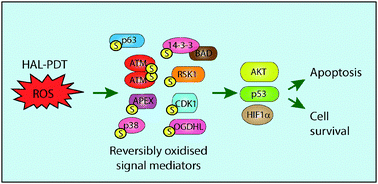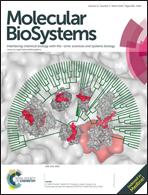Photodynamic treatment with hexyl-aminolevulinate mediates reversible thiol oxidation in core oxidative stress signaling proteins†
Abstract
Photodynamic therapy (PDT) is a highly selective two-step cancer treatment involving a photosensitizer and illumination with visible light in the presence of molecular oxygen. PDT is clinically approved worldwide for treating several premalignant conditions and cancer forms, especially endoscopically accessible tumors and dermatological malignancies. PDT-mediated cytotoxicity takes place via autophagy, apoptosis and necrosis, but the exact trigger mechanisms for various death-pathways are still unknown. PDT induces reactive oxygen species (ROS) through photochemical reactions. ROS can react with different macromolecules resulting in cellular damage, including oxidation of proteins. One of the known protein modifications is reversible oxidation of cysteine thiols (-SH), which in many cases constitute a redox switch to modulate protein activity and cellular signaling. Here we have examined the role of reversible oxidation of protein thiols as a potential mediator of cytotoxicity after hexylaminolevulinate-mediated photodynamic treatment (HAL-PDT) in the human epidermoid carcinoma cell line A431. Nearly 2300 proteins were found to be reversibly oxidized after HAL-PDT, of which 374 high-confidence proteins were further allocated to cellular compartments and functional networks. 115 of the high confidence proteins were associated with apoptosis and 257 have previously not been reported to be reversibly oxidized on cysteines. We find an enrichment of DNA damage checkpoint and oxidative stress response proteins. Many of these constitute potential signaling hubs in apoptosis, including ATM, p63, RSK1 p38, APE1/Ref-1 and three 14-3-3 family members. Our study represents the first comprehensive mapping of reversibly oxidized proteins subsequent to HAL-PDT. Several of the proteins constitute potentially novel redox-regulated apoptotic triggers as well as potential targets for adjuvants that may improve the efficacy of HAL-PDT and PDT using other photosensitizers.


 Please wait while we load your content...
Please wait while we load your content...